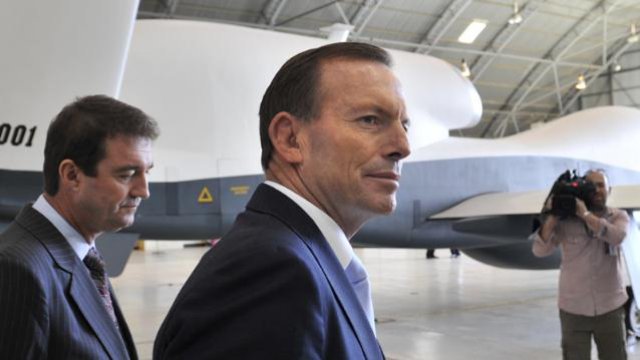 Prime Minister Tony Abbott travelled to South Australia two days out from the state election to announce that the government would buy Tritons, to be based at RAAF Edinburgh outside Adelaide. The deal will be conditional on the US Navy proving this advanced and expensive technology works properly.
Prime Minister Tony Abbott travelled to South Australia two days out from the state election to announce that the government would buy Tritons, to be based at RAAF Edinburgh outside Adelaide. The deal will be conditional on the US Navy proving this advanced and expensive technology works properly.
For that, significant new infrastructure will be needed and Mr Abbott brought along the government chequebook.
There is $140 million for new Triton facilities, with around $100 million to be invested in South Australia.
That will mostly be at RAAF Edinburgh, longtime home of the RAAF’s ageing fleet of AP-3C Orions and their replacements, the new P-8A Poseidons.
Mr Abbott also announced $78 million for defence company BAE Systems in Adelaide as part of a contract for support of the RAAF’s Wedgetail early warning aircraft.
The Northrop Grumman MQ-4C Triton has a wingspan bigger than a Boeing 737 and is able to fly at 16,750 metres or higher for more than 30 hours.
It observes with radar and camera systems, beaming imagery back to ground stations in real time.
Australia’s interest in this capability dates back to the 1990s.
The 2013 Defence White Paper envisaged a mixed fleet of Poseidon manned aircraft and unmanned aircraft to perform the vital maritime surveillance and border protection task which can include search and rescue, observing Japanese whalers and illegal fishers, or patrolling for asylum seeker boats.
Mr Abbott said the government would decide on how many Tritons and timing of their introduction in 2016, based on the upcoming 2015 Defence White Paper.
The US Navy plans to introduce Tritons to service in 2015 and Mr Abbott said Australia’s decision would be subject to successful completion of the US Navy’s development programme.
‘These aircraft will patrol Australia’s vast ocean approaches, and work closely with other existing and future Australian Defence Force assets to secure our ocean resources, including energy resources off northern Australia, and help to protect our borders,’ he said.
RAAF chief Air Marshal Geoff Brown said unmanned systems were pivotal to the RAAF’s future capability and Triton would revolutionise maritime surveillance.
‘The combination of the P-8 and Triton will provide a far better maritime patrol and response capability than we have at this time,’ he said.
